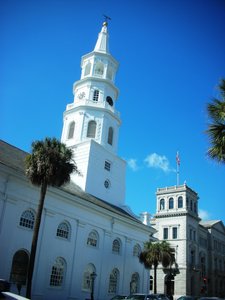Advertisement

 St. Michael's Episcopal Church
St. Michael's Episcopal Church
George Washington worshiped here during his tour of the South. It is the oldest church in Charleston, it's eight bells and clock were imported from England in 1764 and were returned to England as a prize of war during the American Revolution. After my visit to Savannah I was really looking forward to going to Charleston. I decided to take a walking tour; I have always enjoyed those in the past and learned so much from the guides.
It was a beautiful day as we drove the 50+ miles through the South Carolina countryside from Yemassee, the homes along the roadway were all so obviously well cared for. Some of the yards were breathtaking, azaleas, dogwoods, and some flowering trees that I don’t know the name of.
Like Savannah, there is a lot of history in and around Charleston connected to the American Revolution, and Civil War. I was surprised that so many of the houses are private homes, although our guide told us that the homes in the Historic District start at around 4.5 million dollars.
I enjoyed the tour, there were about fifteen folks that day, with everyone but me coming from the northeastern states. I was able to bring Ike along: good job he’s a good little walker. The tour lasted two and a half hours and we were on the go most of the time.
Advertisement
Tot: 0.067s; Tpl: 0.01s; cc: 11; qc: 27; dbt: 0.0495s; 1; m:domysql w:travelblog (10.17.0.13); sld: 1;
; mem: 1mb

 St. Michael's Episcopal Church
St. Michael's Episcopal Church

















Lilian Prinsloo
non-member comment
Sweetgrass Baskets
Hi Lyn, you certainly get around and the baskets shure look like ours here in SA. Wedding preparations must be keeping you all busy!